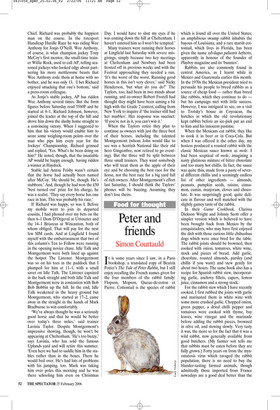Peter and friends
Simon Courtauld
It is some years since I saw, in a Paris bookshop, a translated copy of Beatrix Potter’s The Tale of Peter Rabbit, but I still enjoy recalling the French names given for the four members of the rabbit family: Flopson, Mopson, Queue-de-coton et Pierre. Cottontail is the species of rabbit which is found all over the United States; an amphibious swamp rabbit inhabits the bayous of Louisiana, and a rare marsh cottontail, which lives in Florida, has been given the name sylvilagus palustris hefneris, apparently in honour of the founder of Playboy magazine and its ‘bunnies’.
Rabbits are also commonly found in central America, as I learnt while in Mexico and Guatemala earlier this month. In the 1970s the Mexican president tried to persuade his people to breed rabbits as a source of cheap food — rather than breed like rabbits, which they continue to do but his campaign met with little success. However, I was intrigued to see, on a visit to Trotsky’s house in Coyoacan, the hutches in which the old revolutionary kept rabbits before an ice-pick put an end to him and his innocent pastime.
When the Mexicans eat rabbit, they like to cook it in beer or in Coca-Cola. But when I was offered it the other day, my hostess produced a roasted rabbit with the classic Mexican sauce known as mole. I had been sceptical of mole, imagining a nasty glutinous mixture of bitter chocolate and too many hot chillis. In fact, the sauce was quite thin, made from a paste of several different chillis and a seemingly endless list of other ingredients — almonds, peanuts, pumpkin seeds, raisins, cinnamon, cumin, marjoram, cloves and chocolate. It was surprisingly good, quite delicate in flavour and well matched with the slightly gamey taste of the rabbit.
In their Game Cookbook, Clarissa Dickson Wright and Johnny Scott offer a simpler version which is believed to have been brought back from Mexico by the conquistadors, who may have first enjoyed the dish with those curious little chihuahua dogs which were once bred for the table. The rabbit joints should be browned, then cooked with onion, tomatoes, white wine, stock and pieces of bread. Add garlic, chocolate, roasted almonds, parsley (and chillis if you want) and stew gently for about two hours. The same book also has a recipe for Spanish rabbit stew, incorporating garlic, anchovy fillets, capers, lemon juice, cinnamon and a strong stock.
For the rabbit stew which I have recently cooked, I first rubbed the joints with garlic and marinated them in white wine with some more crushed garlic. Chopped onion, green pepper, a dried chilli pepper and tomatoes were cooked with thyme, bay leaves, wine vinegar and the marinade before adding the rabbit pieces, browned in olive oil, and stewing slowly. Very tasty it was, the more so for the fact that it was a wild rabbit, now generally available from good butchers. (My farmer son tells me that rabbits must be eaten before they are fully grown.) Forty years on from the myxomatosis virus which ravaged the rabbit population, there is no need to buy the blander-tasting farmed animals, though admittedly those imported from France nowadays are a good deal better than the tame rabbits which, according to Cassell’s Cooking Dictionary published in 1953, ‘sometimes taste of cabbages on which they are usually fed’.
I notice that the liver and kidneys are used in some recipes, especially when making rabbit terrine, which should also include pork, garlic, herbs, breadcrumbs and brandy. I put the chopped kidneys together with a filleted saddle of rabbit and wrapped them in bacon before roasting the parcel in a hot oven and eating it with a mustard and cream sauce and mashed potatoes. A very good combination, though the meat was a bit chewy possibly the animal was past its youthful best. Simon Hopkinson, in his Roast Chicken and Other Stories, insists that some rabbit dishes should be made with the French farmed variety, and this may be one of them.
The next day I cooked the legs slowly, and more successfully, having first fried them briefly in goose fat. Chopped garlic, balsamic vinegar and pork stock were added (you could use a meat glaze, if you have one) and left to simmer gently with the rabbit for about 45 minutes. Having reduced the liquid still further to a thickish sauce, I made a rather good parsnip purée, with milk and a little mustard, and put together a salad which, in the words of one rabbit recipe, ‘captures the spirit of Mr McGregor’s garden’.



































































 Previous page
Previous page